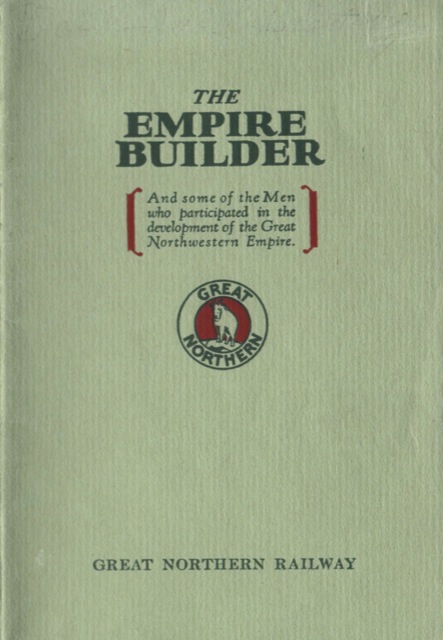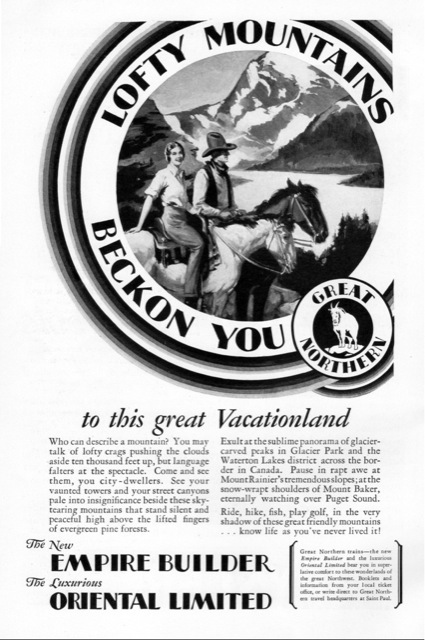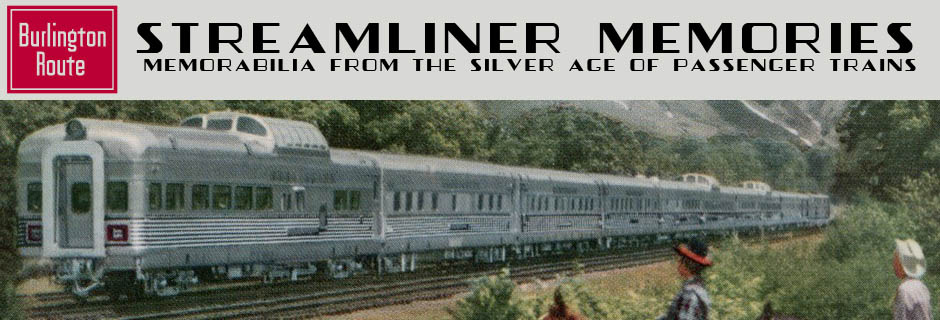To mark the opening of the railway’s Cascade Tunnel, on June 11, 1929, the Great Northern inaugurated a new train, the Empire Builder, named for the railway’s founder, James J. Hill. This brochure describes it as a “companion train” for the Oriental Limited, but the Empire Builder was on a faster schedule while the Oriental Limited effectively replaced the Glacier Park Express as the train that carried tour cars to Glacier Park in the summer. As with the 1924 Oriental Limited, the Empire Builder‘s name was painted on each car’s letter boards.

Click image to download a 10.1-MB PDF of this 36-page booklet.
The new train included refurbished steel coaches from the pre-1924 Oriental Limited but new sleeping and observation cars. Although the train still included some 12-and-1 sleepers, more common were cars with eight sections, one drawing room, and two compartments (for a total of 23 beds), reflecting a trend towards more private rooms.
The observation cars had no revenue space at all, allowing room for the women’s lounge, barber shop, buffet, and 37 non-revenue seats in three different rooms. For the first time on a Great Northern transcontinental train, the observation car didn’t have an open platform, instead having an “observation sun room” with extra large windows.
As the above booklet describes, the Great Northern named the train’s principal sleeping and observation cars after noted “empire builders” (meaning railroad managers and financiers), pioneers, and army officers. James J. Hill’s original partners, George Stephen, Donald Smith, and Norman Kittson, are all included. But the second name on the list (after Hill himself) was someone named Daniel Willis James, who played little role in GN’s history except for joining the company’s board of directors in 1882, well after the company was a proven success. No doubt his name was prominent because by 1929 his son, Arthur Curtis James, was one of GN’s largest stockholders and a major backer of Ralph Budd’s plan to extend the Great Northern from Bend, Oregon into California.
Similarly, Cyrus H. Jenks was probably included partly because his son, Cyrus O. Jenks, was in 1929 the Great Northern’s vice-president of operations. George Baker, still living in 1929, was also a major GN stockholder. Also still living were George Winship, retired editor of the Grand Forks Herald; William Brown, an army general who once surveyed much of what became Glacier National Park; and Huge Scott, the major-general who accompanied the Upper Missouri and Columbia River Historical Expeditions.
In all, Empire Builder Pullman cars were named after 36 men. The train required seven train sets, so each one would have five of these cars with one left over for extra demand or rotational purposes. The train also included coaches and tourist sleeping cars, but these weren’t named.

This 1930 ad mentions the “new Empire Buider,” though tourists wanting to stop at Glacier would have to take the Oriental Limited. Click image for a larger view.
To pull the train, GN ordered more powerful 4-8-4 “Northern” locomotives to use in the mountains in place of the 4-8-2 “Mountain” locomotives used on the Oriental Limited. The 4-8-2’s were still used on the prairies. The Northerns were about 25 percent more powerful than the Mountains, and could probably go faster as well, as the Mountains were limited to about 50 mph. In 1930, GN took delivery of a new batch of Northerns with 80-inch drivers (as opposed to 73 inches on the previous Northerns and Mountains). The taller drivers meant the trains could go even faster, but reduced the nominal power.
